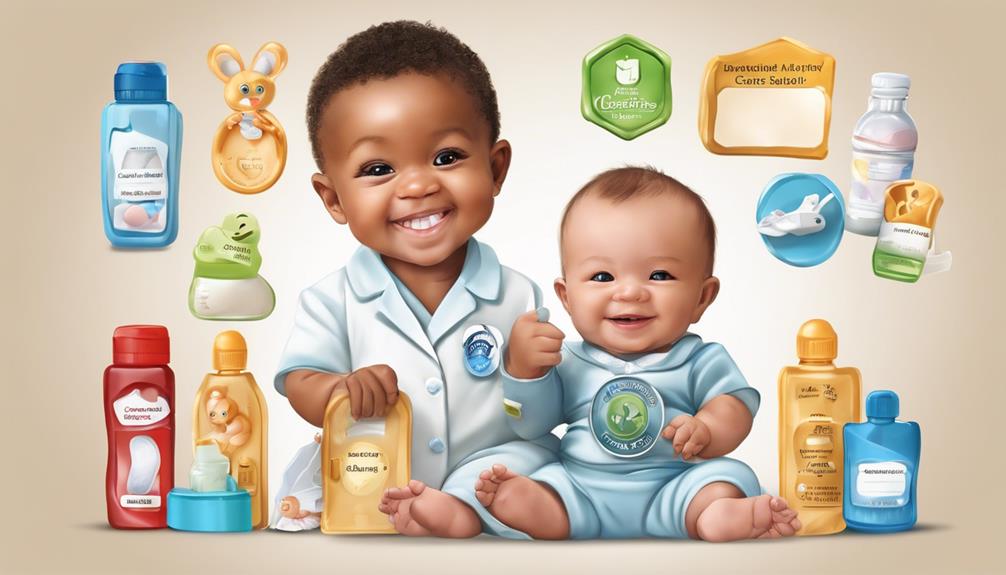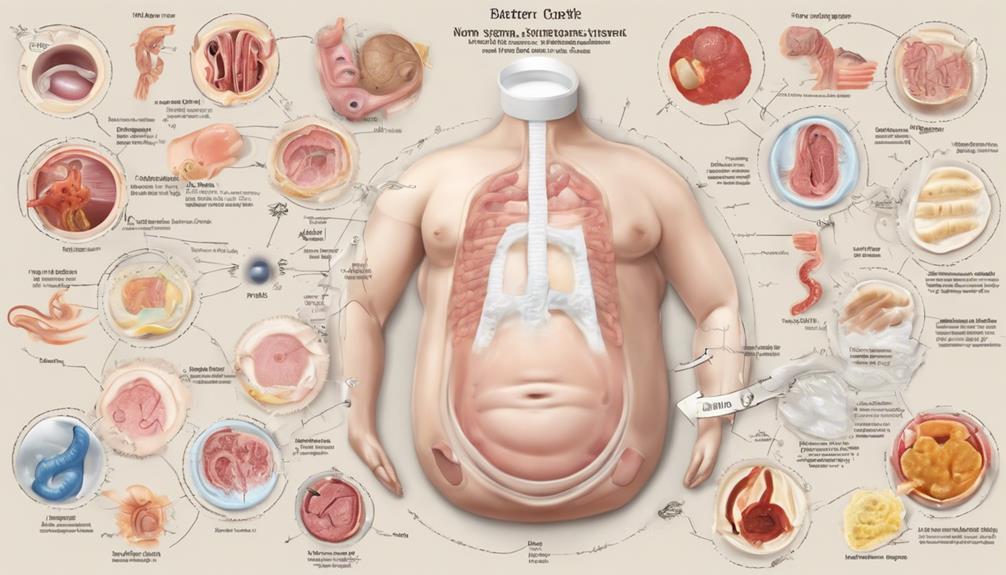For new parents, learning how to care for a newborn can feel like learning a complex dance routine; every step is crucial for the baby’s well-being. From understanding the correct feeding techniques to soothing the baby, beginning the journey of parenthood is a deeply significant adventure.
But what are the top 10 ways to care for your precious little one in those early days? Let's explore these essential practices that can set a strong foundation for your baby's growth and development, ensuring a harmonious start to your parenting journey.
Key Takeaways
- Ensure correct latching and feeding schedule for newborn's nutrition and growth.
- Practice proper hygiene and skincare to keep your baby clean and healthy.
- Use comforting techniques like swaddling and gentle rocking for a happy, content baby.
- Follow safe sleep practices, such as back sleeping and a firm mattress, for your baby's safety.
Feeding Your Newborn
When caring for your newborn, ensuring proper feeding is essential to their growth and well-being. Breastfeeding offers essential nutrients and fosters a deep bonding experience between you and your baby. It's recommended for the first 6 months of life.
Correct latching during breastfeeding is critical to make sure your newborn receives an adequate amount of milk and to prevent discomfort for both of you. If breastfeeding isn't an option, using doctor-recommended formula can be a suitable alternative.
Newborns typically feed every 2 to 3 hours, amounting to 8-12 feedings per day. Each feeding may consist of 60 to 90 ml of formula to meet your baby's nutritional needs.
Establishing a feeding schedule that aligns with your newborn's natural rhythm can help create a sense of predictability and comfort for both of you. Remember, this feeding time isn't just about nourishment; it's also a precious moment for bonding with your little one.
Diapering Essentials

When it comes to diapering essentials for your newborn, it's important to pay attention to the proper diaper size, changing techniques, and diaper rash prevention.
Making sure the diaper fits correctly, using the right wipes and creams, and changing frequently are key to keeping your baby comfortable and healthy.
Proper Diaper Size
Looking to guarantee your newborn's comfort and protection? Choosing the right diaper size is crucial for ensuring your baby stays dry and happy. Proper diaper sizing not only prevents leaks but also helps in avoiding skin irritation. For newborns, size NB (newborn) diapers are ideal, fitting babies up to 10 pounds. As your little one grows, size 1 diapers, suitable for 8-14 pounds, provide a snug fit for added protection. Always refer to the weight recommendations on the diaper packaging to select the appropriate size for your baby. By paying attention to diaper sizes, you can keep your newborn cozy and content.
| Diaper Size | Baby Weight (lbs) |
|---|---|
| NB (Newborn) | Up to 10 |
| Size 1 | 8-14 |
Changing Techniques
To confirm your newborn's comfort and hygiene, mastering the proper changing techniques is essential for every parent or caregiver. Change your baby's diaper frequently, around 6 to 8 times a day, to maintain cleanliness and prevent diaper rashes.
When changing diapers, use gentle wipes and apply diaper rash cream to protect your baby's sensitive skin. Properly dispose of diapers to uphold hygiene standards and prevent contamination. Thoroughly clean the diaper area during each change to reduce the risk of skin irritation and infections.
Keep a close eye on the umbilical cord stump for any signs of infection, following the healthcare provider's instructions for cleaning it with lukewarm water. Prioritize your baby's hygiene and comfort during diaper changes for a happy and healthy little one.
Diaper Rash Prevention
Frequent diaper changes, gentle wipes, and the use of diaper rash cream are essential in preventing diaper rash for your baby's comfort and well-being. Remember to change diapers frequently to reduce the risk of diaper rash.
Opt for gentle wipes and steer clear of harsh chemicals that could irritate your baby's delicate skin. During diaper changes, apply diaper rash cream preventively to create a protective barrier.
Additionally, allow the diaper area to air out and stay dry between changes to help prevent diaper rash. If despite these preventive measures the rash persists or worsens, don't hesitate to consult your pediatrician for further guidance and care.
Bathing and Skincare Tips
Let's talk about the essential aspect of bathing and skincare for your newborn baby.
Understanding the frequency and timing of baths, choosing safe skincare products, and handling your baby's delicate skin are critical for their well-being.
Bathing Frequency and Timing
When caring for your newborn baby's delicate skin, it is essential to contemplate the appropriate bathing frequency and timing. Sponge baths with mild baby soap and warm water are recommended until the umbilical cord falls off, typically within the first few weeks. It's important to maintain proper hygiene by cleaning the diaper area thoroughly during each bath to avoid irritation and infections. Remember to pat dry your baby gently after the bath to prevent moisture-related skin issues like diaper rash. Additionally, trimming your newborn's nails carefully is important to prevent accidental scratching during bathing and other activities. Ensuring these practices are part of your routine will help keep your baby clean, comfortable, and healthy.
| Bathing Tip | Description | Importance |
|---|---|---|
| Sponge Baths | Use mild baby soap and warm water until the umbilical cord falls off. | Gentle cleansing |
| Cleaning Diaper Area | Thoroughly clean the diaper area during each bath to prevent irritation and infections. | Hygiene maintenance |
| Pat Dry After Bath | Gently pat dry your baby to prevent moisture-related skin issues like diaper rash. | Skin health |
| Trim Nails Carefully | Trim your newborn's nails carefully to avoid accidental scratching during activities. | Prevent skin injuries |
Safe Skincare Product Choices
Considering the gentle care required for your newborn's skin, selecting safe skincare products is paramount to maintaining their delicate skin health.
- Choose skincare products specifically designed for newborns to avoid harsh chemicals.
- Look for products that are hypoallergenic and fragrance-free to prevent skin irritations.
- Opt for gentle baby wash and shampoos that are tear-free to protect your baby's delicate skin and eyes.
- Avoid using adult skincare products on your newborn as they may contain ingredients that are too harsh.
- Consult with your pediatrician if you have any concerns about which skincare products to use on your newborn.
Handling Baby's Delicate Skin
To care for your newborn's delicate skin, remember to use lukewarm water and mild baby soap for their daily face and neck wash. Gently wiping your baby's eyes with warm water using a cotton ball helps maintain eye hygiene. Washing their hair with gentle baby shampoo up to three times a week prevents scalp irritation. Trimming your baby's nails with baby nail clippers or blunt-nosed scissors is essential to avoid accidental scratching. Wait 24 hours after birth for the first bath and then bathe your baby 2-3 times a week to maintain skin health.
| Baby's Skincare Routine | Frequency |
|---|---|
| Face and Neck Wash | Daily |
| Eye Hygiene | As needed |
| Hair Wash | Up to 3 times/week |
| Nail Trimming | Regularly |
| Bathing | 2-3 times/week |
Soothing Techniques for Newborns

Using gentle techniques such as swaddling or rocking can effectively soothe newborns and create a comforting environment for them. When exploring soothing techniques for newborns, it's crucial to try out different methods to find what works best for your little one.
Here are some options to explore:
- Swaddling: Wrapping your baby snugly in a blanket can mimic the cozy environment of the womb and help them feel secure.
- Gentle Rocking: Gently swaying or rocking your baby in your arms can have a calming effect and lull them into a peaceful state.
- Calming Music: Playing soft, soothing music can create a relaxing atmosphere and help your baby drift off to sleep.
- White Noise: The gentle hum of white noise machines can mask other sounds and provide a soothing background for your baby.
- Warm Wipes: Using warm wipes during diaper changes can keep your baby comfortable and make the experience more pleasant for them.
Experimenting with these techniques can help you discover what brings the most comfort and peace to your newborn.
Creating a Safe Sleep Environment

As we guarantee our newborns are comforted and soothed, it's paramount to create a safe sleep environment for them to promote their well-being and reduce the risk of SIDS. Placing your newborn on their back to sleep, as recommended by the American Academy of Pediatrics, is vital in reducing the chances of SIDS.
Make sure the crib has a firm mattress with no loose bedding, pillows, or toys to provide a safe sleeping space. Room-sharing with your newborn can foster bonding and make nighttime feedings easier, but remember to avoid bed-sharing for safety reasons.
Changing your baby's head position nightly can help prevent a flat spot on their skull. Additionally, dress your baby in appropriate sleep attire and maintain a comfortable room temperature to prevent overheating during sleep.
Understanding Newborn Crying

Understanding why newborns cry is essential for caregivers to respond effectively to their needs and provide comfort. Newborns rely on crying as a means of communication, expressing various needs like hunger, discomfort, pain, or fatigue. It's a normal and crucial way for them to seek attention and care.
On average, newborns cry for 1 to 3 hours a day, often peaking in the evening. By paying close attention to your baby's cues and promptly addressing them, you can help reduce crying episodes and guarantee their well-being. Consoling techniques such as swaddling, gentle rocking, or skin-to-skin contact can be effective in soothing a crying newborn.
Umbilical Cord Care
To properly care for your newborn's umbilical cord stump, make sure it remains clean and dry until it naturally falls off, typically within 1 to 3 weeks. Use lukewarm water and mild soap to gently clean around the base of the stump, making certain no moisture accumulates.
It's important to avoid covering the stump with tight clothing to guarantee air circulation and aid in the drying process. Keep a close eye out for any signs of infection, such as redness, swelling, a foul odor, or discharge. If you notice any of these symptoms, seek medical advice promptly to prevent complications.
Bonding With Your Baby

Let's talk about some key points on bonding with your newborn.
Skin-to-skin contact isn't only comforting but also helps regulate your baby's temperature.
Making eye contact and smiling while talking to your baby can establish a strong emotional connection right from the start.
Skin-To-Skin Contact
Bonding with your newborn baby through skin-to-skin contact is an important practice that offers numerous benefits for both you and your little one.
- Skin-to-skin contact regulates the baby's temperature, heart rate, and breathing, promoting bonding.
- It helps stabilize the baby's blood sugar levels and encourages breastfeeding success.
- Skin-to-skin contact reduces stress for both the baby and parent, leading to improved emotional well-being.
- Babies who experience skin-to-skin contact have better weight gain and sleep patterns.
- This bonding technique releases oxytocin, the 'love hormone,' fostering a strong connection between parent and baby.
Eye Contact and Smiling
Establishing eye contact and sharing smiles with your newborn is an essential aspect of nurturing the emotional bond between parent and child. Making eye contact helps create a strong connection and sense of security and trust for your baby. Babies are naturally drawn to faces and respond positively to eye contact, which can lead to joyful responses when you smile at them. This interaction is vital for your baby's social and emotional development as they learn to interpret facial expressions and communicate. Engage in eye contact and smiling interactions frequently to strengthen the bond with your little one and foster a loving relationship built on understanding and connection.
| Benefits of Eye Contact and Smiling |
|---|
| Promotes Bonding |
| Enhances Communication |
| Supports Emotional Development |
Managing Newborn Sleep Patterns

To enhance your newborn's sleep quality, consider implementing a consistent bedtime routine to promote healthy sleep patterns. Here are some tips to help manage your baby's sleep patterns effectively:
- Create a Calming Bedtime Routine: Establish a soothing routine involving activities like bathing, reading, or gentle rocking to signal bedtime to your baby.
- Experiment with Gentle Sleep Training: Around 5 months, try gentle sleep training methods to encourage longer periods of uninterrupted sleep for both you and your little one.
- Consistency is Key: Stick to a consistent bedtime routine to help your baby anticipate sleep, making it easier for them to settle down.
- Observe Nap Patterns: Most babies naturally nap around 9 a.m. and 2 p.m. by 9 months, so pay attention to these patterns and schedule naps accordingly.
- Winding-Down Activities: Engage in calming activities before bedtime, such as dimming lights or playing soft music, to help your baby relax and prepare for sleep.
Partner Involvement in Caregiving

Active involvement of partners in caregiving tasks is key to fostering a strong bond with the newborn and creating a supportive parenting environment. When partners actively engage in caregiving responsibilities, they experience increased bonding with the baby.
Sharing caregiving tasks promotes a balanced and supportive parenting dynamic, establishing a sense of teamwork and shared responsibility. Communication between partners about caregiving needs and preferences is essential for effective co-parenting.
Encouraging partner involvement in caregiving tasks not only provides mutual support but also strengthens the parent-child relationship. By working together to care for the newborn, partners can create a nurturing environment that benefits both the baby and the parents.
Embracing this shared responsibility fosters a sense of unity and collaboration in raising the child, leading to a more fulfilling and harmonious parenting journey.
Frequently Asked Questions
What Are the Most Important Ways to Care for Your Newborn?
Taking care of a newborn involves ensuring they sleep on their back, practicing skin-to-skin contact, maintaining a feeding schedule, keeping the umbilical cord stump clean, and monitoring hygiene. These steps are essential for your baby's well-being.
What Are the 4 Essentials of Newborn Care?
When caring for a newborn, essentials include gentle bathing, cleaning the diaper area thoroughly, and trimming nails carefully. These practices promote hygiene, prevent infections, and keep the baby comfortable. Embrace these routines with care and attention.
What Are the 5 Steps of Newborn Care?
We guarantee newborn care by feeding every 2-3 hours, changing diapers frequently, supporting the baby's head and neck, promoting bonding through skin-to-skin contact, and monitoring health vigilantly. These steps are vital for the baby's well-being.
How Do You Take Care of a Newborn After Birth?
After birth, we prioritize skin-to-skin contact, breastfeeding within the first hour, and monitoring breathing and color to make certain our newborn is healthy. Keeping the umbilical cord stump clean and seeking medical help for any concerns are essential.
Conclusion
To sum up, taking care of your newborn baby is a rewarding yet challenging journey. Remember to prioritize your baby's needs and well-being, even if it means sacrificing some of your own comforts.
It's ironic how the smallest beings can bring the biggest changes in our lives. Embrace the chaos, trust your instincts, and seek support when needed.
Parenthood is a wild ride, but the love and joy it brings make it all worth it.










